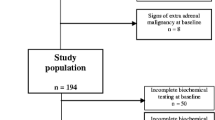Abstract
Adrenal adenoma is the most frequent lesion among adrenal incidentalomas. The present retrospective study was undertaken to investigate medium-term evolution of supposed or ascertained adrenocortical adenomas in a group of 53 subjects (16 males and 37 females, aged 31–83 yr), with bilateral (no.=8) or monolateral (no.=45) incidentally discovered adrenal masses (size 10–50 mm, median 25 mm), who were followed-up for 6–78 months (median 24 months). Diagnosis of adenoma was based on size and morphovolumetric aspect of the lesion at computed tomography (CT), scintigraphic pattern using NP59 as a tracer, and it was histologically confirmed in 7 patients. After an extensive hormonal investigation including morning (no.=53) and midnight (no.=28) serum cortisol, plasma ACTH (no.=50), serum DHEAS (no.=51), daily urinary free cortisol excretion (no.=52), post-dexamethasone (1 mg) cortisol (no.=42) and ACTH stimulation test for 17-hy-droxyprogesterone (17-OHP) response (no.=48) at the time of diagnosis, patients were periodically re-evaluated for hormonal function and radiological aspect of the lesion(s) by CT. Seven patients underwent surgery 6–42 months after incidentaloma demonstration, with histological diagnosis of adrenal adenoma. During follow-up an increase in the size of the lesion was demonstrated in 22 patients (41.5%); the increase was greater than 10 mm in 8 cases. In 3 patients with unilateral mass, a contralateral lesion appeared 10–52 months after first demonstration. Six patients (11.3%) showed reduction or disappearance of the lesions. On the basis of the hormonal evaluation 3 patients were considered to have subclinical Cushing’s syndrome and 10 patients exhibited 17-OHP hyperresponse to ACTH test consistent with partial 21-hydroxylase deficiency. A significant difference in the size of the lesions was observed between patients with or without 17-OHP hyperresponse to ACTH test (31.1±1.9 vs 24.1±1.2 mm; p<0.01). No significant changes in the hormonal parameters were observed in the patients, when retested. In conclusion, although none of the patients of the present series exhibited evolution to hypersecretion or to aberrant growth, in more than 40% of patients an increase in the size of the mass was observed, even after a long period of “quiescence”. This suggests that a radiological re-evaluation of lesions should be periodically undertaken.
Similar content being viewed by others
References
Copeland P.M. The incidentally discovered adrenal mass. Ann. Intern. Med. 1983, 98: 940–945.
Ross N.S., Aron D.C. Hormonal evaluation of the patient with an incidentally discovered adrenal mass. N. Engl. J. Med. 1990, 323: 1401–1405.
Kloos R.T., Gross M.D., Francis I.R., Korobkin M., Shapiro B. Incidentally discovered adrenal masses. Endocr. Rev. 1995, 16: 460–484.
Reincke M., Nieke J., Krestin G.P., Saeger W., Allolio B., Wilkelmann W. Preclinical Cushing’s syndrome in adrenal “incidentalomas”: comparison with adrenal Cushing’s syndrome. J. Clin. Endocrinol. Metab. 1992, 75: 826–832.
Ambrosi B., Peverelli S., Pasini E., Re T., Ferrario R., Colombo P., Sartorio A., Faglia G. Abnormalities of endocrine function in patients with clinically “silent” adrenal masses. Eur. J. Endocrinol. 1995, 132: 422–428.
Terzolo M., Osella G., Alì A., Borretta G., Cesario P., Pacotti P., Angeli A. Subclinical Cushing’s syndrome in adrenal inciden-taloma. Clin. Endocrinol. (Oxf.) 1998, 48: 89–97.
Jaresch S., Kornely E., Kley H., Schlaghecke R. Adrenal incidentaloma and patients with homozygous or heterozygous congenital adrenal hyperplasia. J. Clin. Endocrinol. Metab. 1992, 74: 685–689.
Seppel T., Schlaghecke R. Augmented 17α-hydroxyprogesterone response to ACTH stimulation as evidence of decreased 21-hy-droxylalase activity in patients with incidentally discovered adrenal tumours (“incidentalomas”). Clin. Endocrinol. (Oxf.) 1994, 41: 445–451.
Terzolo M., Osella G., Alì A., Borretta G., Magro G.P., Termine A., Pacotti P., Angeli A. Different patterns of steroid secretion in patients with adrenal incidentaloma. J. Clin. Endocrinol. Metab. 1996, 81: 740–744.
Barzon L., Scaroni C., Sonino N., Fallo F., Paoletta A., Boscaro M. Risk factors and long-term follow up of adrenal incidentalomas. J. Clin. Endocrinol. Metab. 1999, 84: 520–526.
Mantero F., Terzolo M., Arnaldi G., Osella G., Masini A.M., Alì A., Giovagnetti M., Opocher G., Angeli A. A survey on adrenal incidentaloma in Italy. J. Clin. Endocrinol. Metab. 2000, 85: 637–644.
Flecchia D., Mazza E., Carlini M., Blatto F., Olivieri F., Serra G., Camanni F., Messina M. Reduced serum levels of dehydroepiandrosterone sulphate in adrenal incidentalomas: a marker of adrenocortical tumour. Clin. Endocrinol. (Oxf.) 1995, 42: 129–134.
Tóth M., Ràcz K., Varga I., Adleff V., Jakab C., Futo L., Kiss R., Gláz E. Plasma dehydroepiandrosterone sulfate levels in patients with hyperfunctioning and non-hyperfunc-tioning adrenal tumors before and after adrenal surgery. Eur. J. Endocrinol. 1997, 136: 290–295.
Lane M.A., Ingram D.K., Ball S.S., Roth G.S. Dehydroepiandrosterone sulfate: a biomarker of primate aging slowed by calorie restriction. J. Clin. Endocrinol. Metab. 1997, 82: 2093–2096.
Gross M.D., Shapiro B., Francis I.R., Glazer G.M., Bree R.L., Arcomano M.A., Schteingart D.E., McLeod M.K., Sanfield J.A., Thompson N.W. Scintigraphic evaluation of clinically silent adrenal masses. J. Nucl. Med. 1994, 35: 1145–1152.
Gross M.D., Shapiro B., Francis I.R., Bree R.L., Korobkin M., McLeod M.K., Thompson N., Sanfield J.A. Scintigraphy of incidentally discovered bilateral adrenal masses. Eur. J. Nucl. Med. 1995, 22: 315–321.
Korobkin M., Brodeur F.J., Yutzy G.G., Francis I.R., Quint L.E., Dunnick N.R., Kazerooni E.A. Differentiation of adrenal adenomas using CT attenuation values. Am. J. Roentgenol. 1996, 166: 531–536.
Korobkin M., Brodeur F.J., Francis I.R., Quint L.E., Dunnick N.R., Londy F. CT time-attenuation washout curves of adrenal adenomas and nonadenomas. Am. J. Roentgenol. 1998, 170: 747–752.
Reznek R.H., Armstrong P. The adrenal gland. Clin. Endocrinol. (Oxf.) 1994, 40: 561–576.
Barry M.K., van Heerden J.A., Farley D.R., Grant C.S., Thompson G.B., Ilstrup D.M. Can adrenal incidentalomas be safely observed? World J. Surgery 1998, 22: 599–604.
Rossi R., Tauchmanova L., Luciano A., Di Martino M., Battista C., Del Viscovo L., Nuzzo V., Lombardi G. Subclinical Cushing’s syndrome in patients with adrenal incidentaloma: clinical and biochemical features. J. Clin. Endocrinol. Metab. 2000, 85: 1440–1448.
Author information
Authors and Affiliations
Corresponding author
Rights and permissions
About this article
Cite this article
Grossrubatscher, E., Vignati, F., Possa, M. et al. The natural history of incidentally discovered adrenocortical adenomas: A retrospective evaluation. J Endocrinol Invest 24, 846–855 (2001). https://doi.org/10.1007/BF03343941
Accepted:
Published:
Issue Date:
DOI: https://doi.org/10.1007/BF03343941




